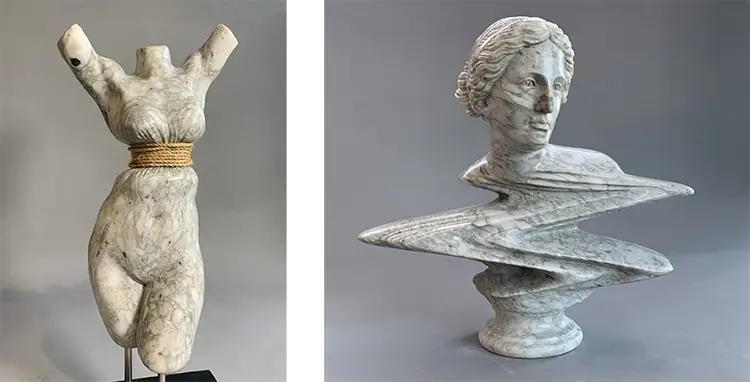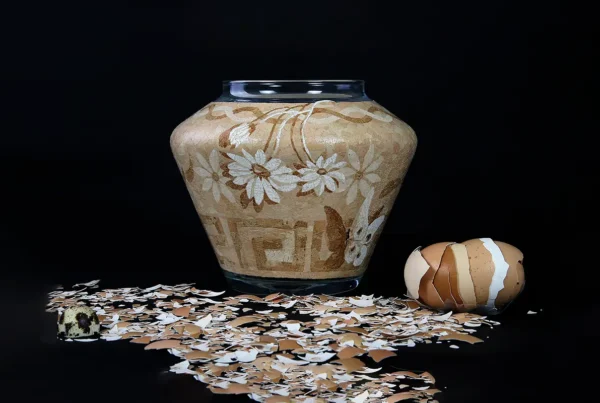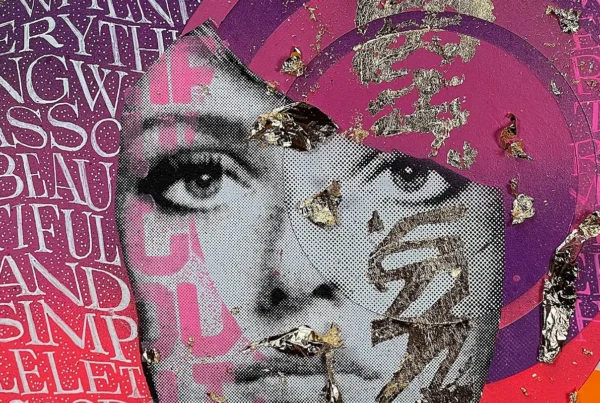Bridging Temporal Frontiers Through Stone and Code
Leo Caillard stands at a rare intersection in contemporary art—where timeless sculptural tradition meets the rapidly shifting terrain of digital innovation. Born in Paris in 1985, Caillard has emerged as a vital voice in both classical and digital artistic conversations, reimagining the contours of form, time, and meaning. His work is not merely an aesthetic exercise in contrast; it is a probing inquiry into how historical narratives shape our understanding of the present and the potential of new technologies to carry those narratives forward. With a background in digital photography and fine arts, his creative path is defined by curiosity and an unwavering commitment to recontextualizing visual language.
Caillard’s foundational training began at the École des Gobelins, where he immersed himself in the technical precision of digital imagery. This early experience honed his ability to manipulate light, texture, and composition—skills that would later inform his digital sculptures and photographic experiments. Further studies in fine arts and art history deepened his engagement with classical forms, while a two-year stay in New York exposed him to the pulse of global contemporary art. Surrounded by dynamic influences, he began to see digital tools not just as instruments but as materials themselves. This paradigm shift gave rise to early projects like Art Game and Hipsters in Stone, where he fused photography with 3D modeling to create arresting visual juxtapositions.
The Hipsters in Stone series, in particular, catapulted Caillard into international attention. Inspired during a visit to the Louvre, the project involved digitally dressing ancient sculptures in modern clothing—hoodies, skinny jeans, and plaid shirts—thus forging an unexpected alliance between distant eras. These visual mashups, at once humorous and provocative, forced viewers to reconsider their assumptions about both antiquity and modern identity. What might initially seem like playful pastiche quickly reveals a deeper intellectual agenda: Caillard’s intent is to reawaken cultural memory and provoke questions about continuity, transformation, and the way history invisibly structures our everyday experience.
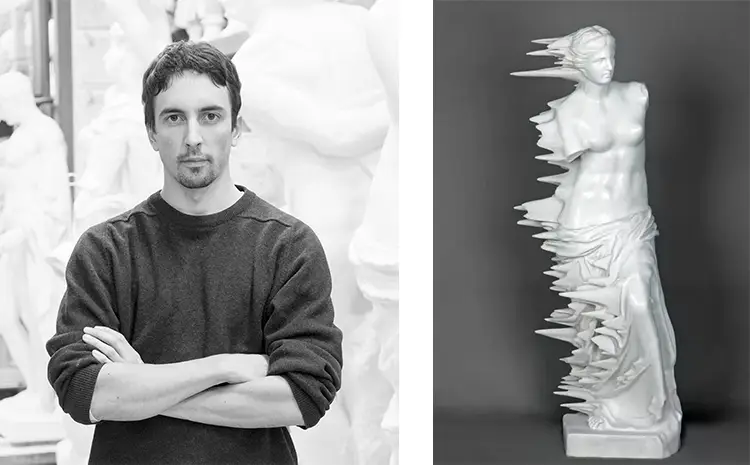
Leo Caillard: Time as Sculptural Dialogue
In Caillard’s view, time is not a linear construct but a fluid continuum, capable of compression, distortion, and reinterpretation through visual art. His fascination with disciplines such as archaeology and anthropology profoundly informs his conceptual framework. He positions himself as a visual thinker attuned to the paradox of human existence: our brief individual lifespans set against the vastness of historical time. His works consistently explore this contradiction, drawing from the past to cast speculative light on the present and future. “I look at history to reimagine our current society,” he says—a statement that encapsulates both his methodology and artistic ethos.
His fascination with temporal dissonance manifests vividly in his sculptural works that integrate visual ‘glitches’—distortions that ripple across otherwise classical forms. Using figures like Venus or Apollo as starting points, Caillard inserts subtle digital aberrations that fracture symmetry and stability. These interventions create a sensation akin to encountering a corrupted file or a fractured memory. They destabilize the viewer’s expectations, yet paradoxically amplify the aesthetic impact. Through this technique, Caillard investigates how our perception of form is increasingly mediated by digital distortion, and how the physical world is being reinterpreted through technological filters.
For Caillard, the act of carving marble and programming algorithms are not contradictory but complementary practices. His use of traditional sculpting techniques connects him with centuries of artistic lineage, while his incorporation of 3D modeling and AI pushes those traditions into previously uncharted territory. In blending the tangible with the immaterial, he crafts a hybrid visual language that reflects the complexities of contemporary life. His work serves as both homage and challenge: a tribute to the endurance of classical art and a proposition for how that legacy might evolve in a digitally saturated culture.
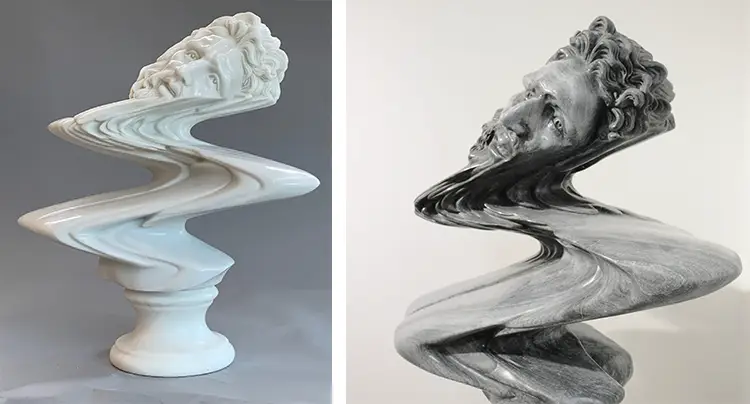
Material Disruption and the Question of Form
Caillard’s recent “glitch sculptures” are among his most compelling explorations of duality in art. These works reinterpret established classical iconography, infusing statues with flowing distortions and digital irregularities that seem to ripple through their surfaces. The result is a startling confluence of permanence and instability—marble that appears to flicker like pixels. In these sculptures, he confronts the viewer with the instability of visual truth in an age defined by screens and simulacra. These disruptions don’t diminish the grace of the original forms; instead, they magnify it by forcing a reconsideration of how form acquires meaning.
The artist sees these glitch works as mirrors of the era we inhabit, where physical and digital experiences bleed into one another with increasing fluidity. Rather than resisting this overlap, Caillard chooses to amplify it. His sculptures do not merely represent hybridization; they embody it. The seemingly corrupted forms are not signs of decay but indicators of transformation. In a time where images are endlessly duplicated and altered, Caillard invites the audience to question what authenticity looks like and whether permanence is even a desirable goal. These works are less about nostalgia and more about a new aesthetic philosophy that accepts instability as intrinsic to beauty.
Collaboration plays a vital role in the execution of his vision. Caillard works closely with teams specialized in post-production and digital imaging, ensuring that both hand-carved and digitally-rendered works meet the same high standard of precision. This collaborative model allows him to move seamlessly between marble and machine, keeping the core ideas consistent while expanding the range of their material expressions. His process is iterative, analytical, and investigative—a continuous feedback loop between concept, medium, and audience. Whether shaping stone or coding a 3D model, Caillard’s approach remains grounded in a single question: how can form communicate the layered realities of time, identity, and perception?
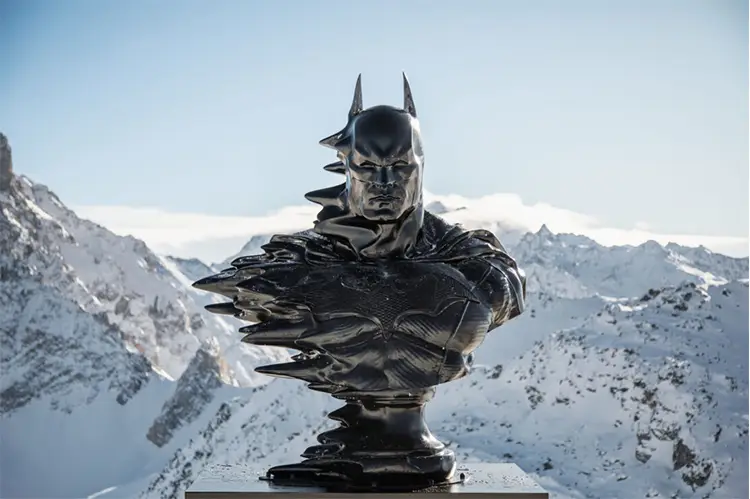
Leo Caillard: Rewriting Art’s Future Through Blockchain and Monumentality
Caillard’s practice extends beyond sculpture and digital experimentation into the transformative terrain of blockchain art. In 2018, he began exploring how decentralized technologies could reshape the relationship between artists and audiences. His early adoption of NFTs was not driven by trend but by a conceptual interest in how authenticity, ownership, and distribution might evolve. Works like Runestone, distributed to over 110,000 collectors, exemplify his ambition to make art accessible while retaining conceptual depth. This democratized approach challenges traditional art market hierarchies, proposing instead a future in which art is both widely owned and intellectually engaged.
Alongside his digital ventures, Caillard continues to gain recognition in prestigious art institutions worldwide. His pieces have been exhibited in venues ranging from the Louvre and LACMA to the Museum of Fine Arts in Boston. These exhibitions situate his work within a global context, affirming the universality of his themes. Caillard sees this international recognition not just as validation but as a responsibility—to create art that speaks across cultural and temporal lines. His sculptures resonate with viewers because they transcend style or medium, offering instead a conceptual continuity that connects ancient history with digital futures.
Among his most significant accomplishments is a monumental sculpture commissioned for La Défense, the iconic business district in Paris. Standing over 3.6 meters tall, the sculpture synthesizes classical form with a digital “wave,” a visual metaphor for the coexistence of heritage and innovation. Set to become a permanent fixture in one of France’s most visible public art spaces, the work symbolizes Caillard’s evolving role as both artist and public communicator. His 2024 commissions, including projects for the Paris Olympics and collaborations with Sotheby’s and Christie’s, mark a turning point in his career. Looking ahead to 2025, Caillard remains focused on expanding the scale and conceptual reach of his practice—anchored by a singular goal: to forge connections between eras, disciplines, and people through the enduring power of visual form.
